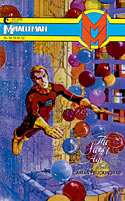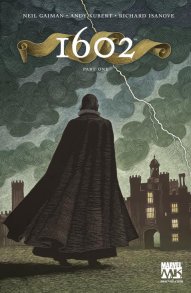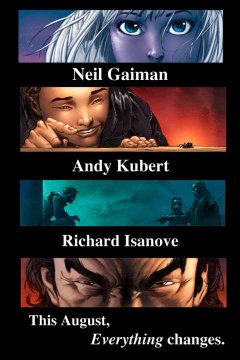| The
1602 Annotations
Shortly
after my own review of the first issue of Neil Gaiman's 1602
for Marvel, I received an e-mail from a writer named Julian
Darius. Like A. David Lewis from Red
Eye Press, Darius considers himself a comics scholar,
and has undertaken a massive project: annotating 1602.
So far, he has notations for the first two issues, and after
reading his work, I look forward to the third.
These
annotations prove both the legitimacy of "comics scholarship"
and the depth of the work Gaiman does. With Darius' permission,
we're reprinting the introduction to his notes, with a link
to his site. If 1602 has left your head spinning a bit, this
will help. Really.
Why
Annotate 1602?
1602
is significant in uniting two worlds: that of the Marvel Universe
of super-heroes, all with their own history, and that of Neil
Gaiman, who brings to the project literary respectability
as well as his revered writing skills. The publication of
the series was not only a major event in comics, but a significant
event in all publication due to Gaiman's considerable talents
and reputation as a best-selling novelist. In both comics
and novels, Gaiman maintains a considerable readership tending
towards the intelligent young and willing to embrace clever
takes on marginalized media, such as comics, and genres, from
fantasy to super-heroes.
So why
annotate 1602? First, why not? Fairly few annotations
of comics are available, despite the maturation of the medium
and the attention it increasingly receives in both scholarly
and entertainment circles. Moreover, 1602 is an important
work in comics by an incredibly important writer in multiple
media. But 1602 is by nature a work that ravenously absorbs
references and traditions: while featuring Marvel characters
in alternate forms, it takes place primarily in late Elizabethan
England. Any reader may not get this wide range of resonances,
many of which are not necessary to follow the story (as narrowly
defined). Any reader, but particularly those of Gaiman's best-selling
novels, may not get 1602's resonances with Marvel Comics'
many decades of history. And any reader may not understand
the historical background into which the series is set. For
these reasons, annotations are of particular value in the
case of 1602.
An ancillary
question is why I should be the one doing the annotations.
First, there's not a lot of competition. Second, my own background
seems perfectly suited to 1602, with both Renaissance English
literature and comic books being areas of particular expertise.
While my formal academic training has been in English literature,
with more training in Renaissance literature than most other
experts in the field, I have privately studied comics even
more intensely -- in an age in which they are academically
marginalized if not non-existent -- and have both published
and presented on comics at international scholarly conferences.
The apparently strange mix (perhaps not as strange as one
would immediately think) of the Renaissance and super-heroes
is shared by both 1602 and my biography. My point, I trust,
made, I now stop burdening you with my credentials.
The
Origin of 1602
 In
the 1980s and 1990s, when Neil Gaiman made his name working
on The Sandman for DC Comics, he expressed no desire to work
for Marvel Comics. Indeed, he expressed his desire not to
do so for the same reason that his mentor Alan Moore had vowed
never again to associate himself with Marvel Comics: Marvel
had promised legal action over the name "Marvelman"
after that British character, who normally appeared in the
British anthology Warrior, got his own Marvelman Special. In
the 1980s and 1990s, when Neil Gaiman made his name working
on The Sandman for DC Comics, he expressed no desire to work
for Marvel Comics. Indeed, he expressed his desire not to
do so for the same reason that his mentor Alan Moore had vowed
never again to associate himself with Marvel Comics: Marvel
had promised legal action over the name "Marvelman"
after that British character, who normally appeared in the
British anthology Warrior, got his own Marvelman Special.
The fact
that Marvelman was published in the 1950s before Marvel Comics
was Marvel Comics made no difference to Marvel, and the threat
of a suit from deep-pocketed Marvel forced the Marvelman feature
to stop appearing and to be changed to Miracleman as it moved
to the U.S. to be reprinted and then continued by Eclipse
Comics. While disdain for Marvel's strong-arm tactics in this
episode caused both Alan Moore and Neil Gaiman to swear off
Marvel Comics, both expressed no real desire to work with
Marvel's characters, who they felt were inferior, or at least
less iconic, than DC's.
The story
of Marvel 1602's genesis is also intertwined with that
of Miracleman, properly regarded as historically important
on the highest level for the evolution of super-heroics and
on which Gaiman had succeeded Alan Moore in the early 1990s
but not finished before publisher Eclipse went bankrupt. Todd
McFarlane, creator of Spawn and cofounder of Image Comics,
bought Eclipse's characters in the bankruptcy auction. Gaiman,
who had created the characters of Angela and Medieval Spawn
for McFarlane, had been in a dispute with McFarlane over royalties
for those characters' subsequent appearances in both comics
and toys. McFarlane offered Gaiman Eclipse's rights to Miracleman,
though what portion of the rights to Miracleman Eclipse actually
held was itself disputed, in exchange for Gaiman surrendering
his claim to the Spawn-related characters he had created;
Gaiman agreed but McFarlane apparently failed to send the
supporting documentation. In 2001, Miracleman's appearance
in McFarlane's Hellspawn title was announced, and Gaiman had
to respond. Now a best-selling writer for his novel American
Gods, Gaiman asked readers to boycott the issues featuring
Miracleman, initially declining to sue. As others rallied
in support of Gaiman and of Miracleman, the limited-liability
company Marvels and Miracles was formed to fight the legal
battles over Miracleman. Gaiman and other creators transferred
to Marvels and Miracles any rights to Miracleman that they
held -- or may have held -- in order to fight the lawsuits
with the eventual interest of having Miracleman published
again.
By 2001,
Marvel Comics had changed dramatically since the dark days
of the 1980s when it had threatened to sue over the name Marvelman.
Joe Quesada had become Editor-in-Chief and had, along with
Marvel President Bill Jemas, aggressively recruited major
comics creators and slowly renovated the entire Marvel line.
Quesada wanted both Moore and Gaiman to work for Marvel, and
he seized the opportunity to strike a deal with Gaiman: Gaiman
would write a mini-series for Marvel and Quesada would donate
Marvel's profits to Marvels and Miracles. In addition, Quesada
expressed a willingness to publish Miracleman, despite its
adult-oriented content in stark odds with Marvel's normal
oeuvre, and promised to allow the name Marvelman, should Gaiman
wish to return to it.
 Before
long, the title of Gaiman's mini-series was announced: 1602.
In an industry where developments within various titles are
typically leaked, publicized, and discussed months in advance,
Quesada had already practiced secrecy to ensure surprise when
he orchestrated the utter media shut-out over the contents
of 1602. For a long time, this ambiguous title was
all anyone knew about the mini-series. Industry journalists
and fans speculated wildly about what this name meant, some
investigating what happened in the year 1602. The artistic
team of illustrator Andy Kubert and colorist Richard Isanove,
who had developed a new artistic style, in which color is
applied in subtle gradations on the computer in a manner mimicking
painted art, for the blockbuster mini-series Origin
(which told Wolverine's origin in expanded form and was held
in similar secrecy), was assigned to 1602. The mini-series
was planned for publication in 2002, but kept being delayed
-- apparently as Gaiman and Marvel expanded its length and
consulted on its content. Besides that it would take in the
entire Marvel Universe in the year 1602, yet somehow
ingeniously not take place in an alternate universe, no one
knew anything more about the title when it was solicited with
a few ambiguous pages in the June 2003 issue of Previews,
published in the last week of May. Marvel 1602 -- the
series's official title -- thus hit the stands on 13 August
2003 with massive publicity but with its contents almost entirely
unknown. Before
long, the title of Gaiman's mini-series was announced: 1602.
In an industry where developments within various titles are
typically leaked, publicized, and discussed months in advance,
Quesada had already practiced secrecy to ensure surprise when
he orchestrated the utter media shut-out over the contents
of 1602. For a long time, this ambiguous title was
all anyone knew about the mini-series. Industry journalists
and fans speculated wildly about what this name meant, some
investigating what happened in the year 1602. The artistic
team of illustrator Andy Kubert and colorist Richard Isanove,
who had developed a new artistic style, in which color is
applied in subtle gradations on the computer in a manner mimicking
painted art, for the blockbuster mini-series Origin
(which told Wolverine's origin in expanded form and was held
in similar secrecy), was assigned to 1602. The mini-series
was planned for publication in 2002, but kept being delayed
-- apparently as Gaiman and Marvel expanded its length and
consulted on its content. Besides that it would take in the
entire Marvel Universe in the year 1602, yet somehow
ingeniously not take place in an alternate universe, no one
knew anything more about the title when it was solicited with
a few ambiguous pages in the June 2003 issue of Previews,
published in the last week of May. Marvel 1602 -- the
series's official title -- thus hit the stands on 13 August
2003 with massive publicity but with its contents almost entirely
unknown.
For Julian
Darius' annotations on 1602, click
here.
|

 In
the 1980s and 1990s, when Neil Gaiman made his name working
on The Sandman for DC Comics, he expressed no desire to work
for Marvel Comics. Indeed, he expressed his desire not to
do so for the same reason that his mentor Alan Moore had vowed
never again to associate himself with Marvel Comics: Marvel
had promised legal action over the name "Marvelman"
after that British character, who normally appeared in the
British anthology Warrior, got his own Marvelman Special.
In
the 1980s and 1990s, when Neil Gaiman made his name working
on The Sandman for DC Comics, he expressed no desire to work
for Marvel Comics. Indeed, he expressed his desire not to
do so for the same reason that his mentor Alan Moore had vowed
never again to associate himself with Marvel Comics: Marvel
had promised legal action over the name "Marvelman"
after that British character, who normally appeared in the
British anthology Warrior, got his own Marvelman Special.
 Before
long, the title of Gaiman's mini-series was announced: 1602.
In an industry where developments within various titles are
typically leaked, publicized, and discussed months in advance,
Quesada had already practiced secrecy to ensure surprise when
he orchestrated the utter media shut-out over the contents
of 1602. For a long time, this ambiguous title was
all anyone knew about the mini-series. Industry journalists
and fans speculated wildly about what this name meant, some
investigating what happened in the year 1602. The artistic
team of illustrator Andy Kubert and colorist Richard Isanove,
who had developed a new artistic style, in which color is
applied in subtle gradations on the computer in a manner mimicking
painted art, for the blockbuster mini-series Origin
(which told Wolverine's origin in expanded form and was held
in similar secrecy), was assigned to 1602. The mini-series
was planned for publication in 2002, but kept being delayed
-- apparently as Gaiman and Marvel expanded its length and
consulted on its content. Besides that it would take in the
entire Marvel Universe in the year 1602, yet somehow
ingeniously not take place in an alternate universe, no one
knew anything more about the title when it was solicited with
a few ambiguous pages in the June 2003 issue of Previews,
published in the last week of May. Marvel 1602 -- the
series's official title -- thus hit the stands on 13 August
2003 with massive publicity but with its contents almost entirely
unknown.
Before
long, the title of Gaiman's mini-series was announced: 1602.
In an industry where developments within various titles are
typically leaked, publicized, and discussed months in advance,
Quesada had already practiced secrecy to ensure surprise when
he orchestrated the utter media shut-out over the contents
of 1602. For a long time, this ambiguous title was
all anyone knew about the mini-series. Industry journalists
and fans speculated wildly about what this name meant, some
investigating what happened in the year 1602. The artistic
team of illustrator Andy Kubert and colorist Richard Isanove,
who had developed a new artistic style, in which color is
applied in subtle gradations on the computer in a manner mimicking
painted art, for the blockbuster mini-series Origin
(which told Wolverine's origin in expanded form and was held
in similar secrecy), was assigned to 1602. The mini-series
was planned for publication in 2002, but kept being delayed
-- apparently as Gaiman and Marvel expanded its length and
consulted on its content. Besides that it would take in the
entire Marvel Universe in the year 1602, yet somehow
ingeniously not take place in an alternate universe, no one
knew anything more about the title when it was solicited with
a few ambiguous pages in the June 2003 issue of Previews,
published in the last week of May. Marvel 1602 -- the
series's official title -- thus hit the stands on 13 August
2003 with massive publicity but with its contents almost entirely
unknown.




